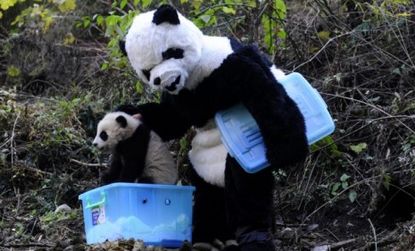The return of the giant panda
A breeding breakthrough heralds a brighter future for the much-loved symbol of China

Chinese scientists have announced that after decades of trying, they have finally arrived at a reliable method for breeding captive pandas. The big innovation? Tricking panda mothers into thinking they're only taking care of one baby, when in fact they're mothering two. Only a few thousand wild pandas remain (all of them in China), and the species is classified as endangered, so this is big news for the species' future survival. Here's a brief guide to developments that could have a dramatic effect on the panda population.
What is the breakthrough?
Conservationists have successfully bred 300 pandas through a method that involves a healthy dose of deception. At the Chengdu Research Base of Giant Panda Breeding in Sichuan Province, researchers know that pandas often give birth to twins, and that mothers almost always abandon one cub because they lack the milk and energy to care for two. So when a panda gives birth to two babies, "the twins are switched up to ten times a day so the mother feeds and cares for both while being under the impression that there is only one." This innovative technique has "finally opened the way to a 100 percent survival rate in newborn captive cubs," and promises to introduce grown pandas into the wild within 15 years.
Subscribe to The Week
Escape your echo chamber. Get the facts behind the news, plus analysis from multiple perspectives.

Sign up for The Week's Free Newsletters
From our morning news briefing to a weekly Good News Newsletter, get the best of The Week delivered directly to your inbox.
From our morning news briefing to a weekly Good News Newsletter, get the best of The Week delivered directly to your inbox.
Why are we hearing about it now?
A BBC documentary crew was given "unprecented access" to the technique over the past two years, which has led to the recent media exposure. Their program, called "Panda Makers," is airing this month.
Why is breeding pandas so hard?
Scientists have been trying to breed captive pandas since 1963, but many factors have stood in their way. For one thing, pandas are only able to become pregnant during a 12-to-24 hour window each year. Another problem: Pandas generally seem "turned off" by captivity. Scientists tried to mimic conditions in the wild, but "rare interactions between aroused pairs often ended in disappointment." There are physical limitations, too: "Male pandas have proportionately short penises, meaning pairs must adopt a very exact position in order to mate." Even artificial insemination proves unreliable.
Sign up for Today's Best Articles in your inbox
A free daily email with the biggest news stories of the day – and the best features from TheWeek.com
Are there any other wacky techniques to promote the population?
There sure are. Biologists at nearby Hetaoping Research and Conservation Center for the Giant Panda have been dressing up as pandas in order to ensure that a panda raised in human captivity has "minimal human contact before being reintroduced into the wild." This isn't the first time this type of fakeout has been employed in the name of wildlife; "costumes and puppets have been used elsewhere to raise other endangered species" such as whooping cranes and California condors.
Sources: BBC, Daily Mail, New Scientist
Create an account with the same email registered to your subscription to unlock access.
-
 'Make legal immigration a more plausible option'
'Make legal immigration a more plausible option'Instant Opinion Opinion, comment and editorials of the day
By Harold Maass, The Week US Published
-
 LA-to-Las Vegas high-speed rail line breaks ground
LA-to-Las Vegas high-speed rail line breaks groundSpeed Read The railway will be ready as soon as 2028
By Peter Weber, The Week US Published
-
 Israel's military intelligence chief resigns
Israel's military intelligence chief resignsSpeed Read Maj. Gen. Aharon Haliva is the first leader to quit for failing to prevent the Hamas attack in October
By Justin Klawans, The Week US Published